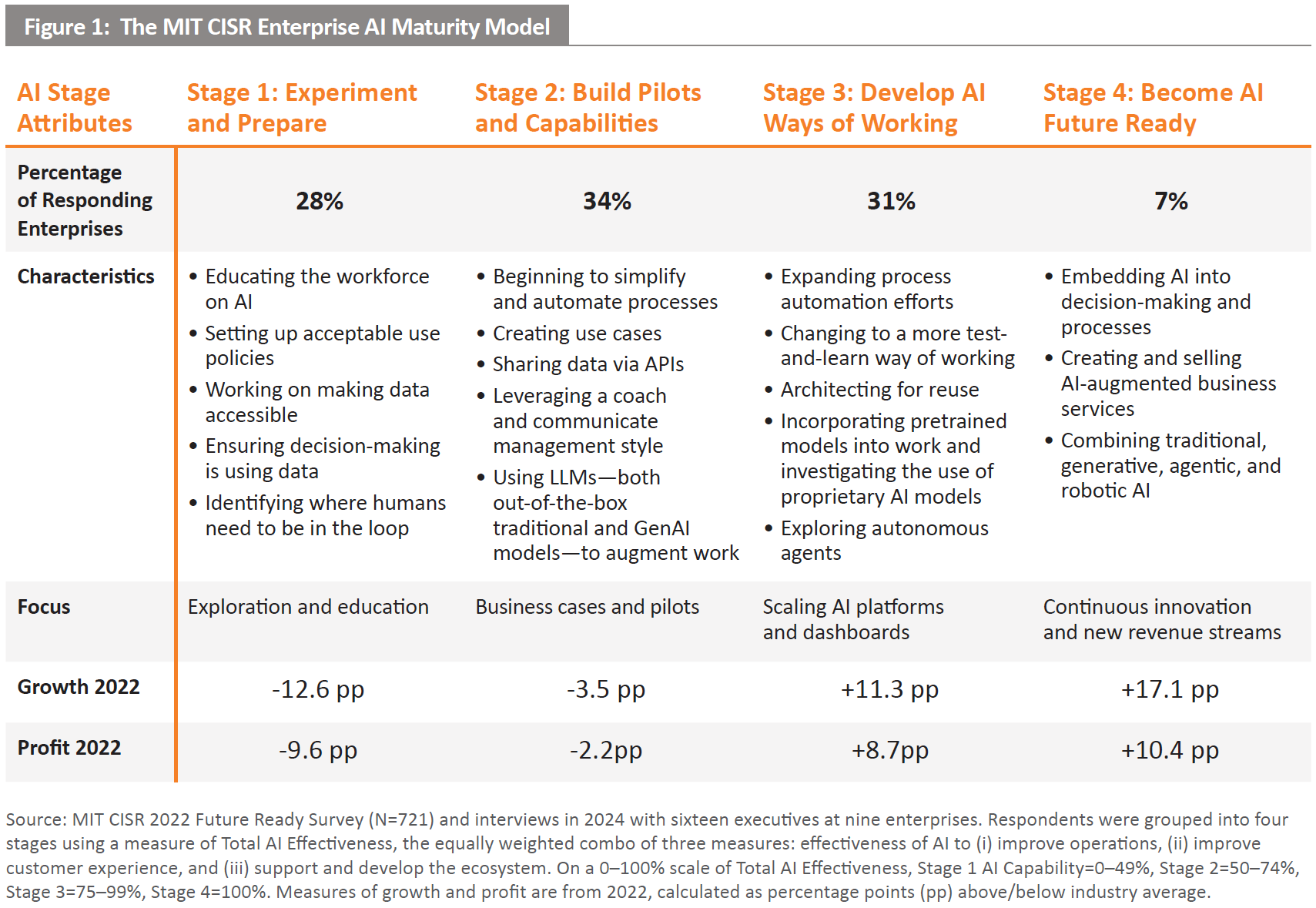Artificial intelligence (AI) has been heralded as both a transformative technology and a harbinger of existential change.
Amid all the hype, research by MIT-CISR’s Peter Weill, Stephanie L. Woerner and Ina M. Sebastian introduces a maturity model for understanding how enterprises create value with AI. Their findings reveal that only organizations in the higher stages of AI maturity consistently outperform their industry peers financially.
MIT-CISR’s AI Maturity Model outlines four stages that enterprises traverse, with distinct characteristics and benefits emerging at each stage. Here’s how these stages break down:

Stage 1: Experiment and Prepare
Key Features: Early-stage enterprises focus on educating their workforce, formulating AI policies and experimenting with AI technologies. Their goal is to build foundational competencies and identify opportunities for AI-driven value creation.
- Stats: 28% of enterprises surveyed are in this stage.
- Actions: Investment in AI literacy for executives and employees, promoting comfort with automated decision-making.
- Example: Kaiser Permanente, a leading US healthcare enterprise, developed seven principles for responsible AI use, focusing on privacy, equity and trust.
Related Article: Open Innovation: Fueling AI That's Responsibly Developed and Useful
Stage 2: Building Pilots and Capabilities
Key Features: Enterprises begin deploying AI pilots to demonstrate value, simplify processes and consolidate data silos. These pilots help these organizations refine their AI strategies and capabilities.
- Stats: 34% of enterprises are in this stage.
- Actions: Companies move from isolated experiments to systematic innovation, tracking pilot outcomes and scaling successful initiatives.
- Example: Guardian Life’s AI pilot, which summarizes underwriting documentation, saves underwriters five hours per day and accelerates process transformation.
Stage 3: Develop AI Ways of Working
Key Features: Enterprises in this stage industrialize AI, building scalable architectures, automating processes and fostering a test-and-learn culture. AI becomes embedded across business operations.
- Stats: 31% of enterprises are at this level.
- Actions: Businesses here leverage platforms to integrate AI across functions, ensuring reusability and scalability.
- Example: Ally, a US digital bank, uses its Ally.ai platform to integrate natural language processing and predictive analytics, saving minutes on millions of customer interactions and accelerating marketing efforts.
Related Article: Leveraging Agentic AI: A New Playbook for Corporate Innovation
Stage 4: Become AI Future Ready
Key Features: AI permeates every aspect of decision-making, with enterprises leveraging proprietary AI capabilities for internal use and as external services. These organizations combine analytical, generative, agentic and robotic AI to maximize impact.
- Stats: Only 7% of enterprises have reached this stage.
- Actions: AI becomes the core driver of innovation, efficiency and new business models.
- Example: Ping An Insurance in China utilizes AI extensively, with 49% of product sales and 82% of service interactions handled by AI. These initiatives save the company RMB 600 million (about $82 million) in labor costs while generating revenue through AI banking services for other institutions.
The Bottom Line: Why AI Maturity Matters
Advancing AI maturity is no longer optional for enterprises striving to remain competitive. MIT-CISR’s research makes it clear: the financial and operational benefits of reaching higher stages of AI maturity are profound.
To unlock AI’s full potential, businesses must move beyond pilots and experiments, embedding AI deeply into their workflows. Success in the AI era requires a commitment to trust, scalability and innovation. By treating AI as a strategic enabler — not just a tool — organizations can drive growth, enhance efficiency and secure long-term industry leadership.
Learn how you can join our contributor community.
